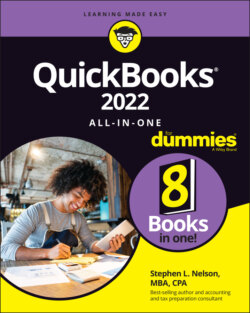Читать книгу QuickBooks 2022 All-in-One For Dummies - Nelson Stephen L., Stephen L. Nelson - Страница 57
Recording a payment
ОглавлениеWhen the business receives payment from the customer for the $1,000 receivable, the business records a journal entry like that shown in Table 3-2.
TABLE 3-2 Journal Entry 2: Recording the Customer Payment
| Account | Debit | Credit |
|---|---|---|
| Cash | $1,000 | |
| Accounts receivable | $1,000 |
Journal Entry 2 shows a $1,000 debit to cash, which is the $1,000 increase in the cash account that occurs because the customer has just paid you $1,000. Journal Entry 2 also shows a $1,000 credit to accounts receivable. This credit to the accounts receivable asset account reduces the accounts receivable balance.
At the point when you record journal entries 1 and 2, the net effect is a $1,000 debit to cash (showing that cash has increased by $1,000) and a $1,000 credit to sales revenue (showing that sales revenue has increased by $1,000). The $1,000 debit to accounts receivable and the $1,000 credit to accounts receivable net to zero.
If you think about this accounts receivable business a bit, you should realize that it makes sense. Although the accounts receivable account includes a $1,000 receivable balance, this just means that the customer owes you $1,000. But when the customer finally pays off the $1,000 bill, you need to zero out that receivable.
QuickBooks, by the way, automatically records journal entries 1 and 2 for you. Journal Entry 1 gets recorded whenever you issue or create a customer invoice. Therefore, you don’t need to worry about the debits and credits shown in Journal Entry 1 except on one special occasion: When you set up QuickBooks and QuickBooks items, you do specify which account should be credited to track sales revenue. So although you may not need to worry much about the mechanics of Journal Entry 1, you should understand how this journal entry works so that you can set up QuickBooks correctly. (Book 2, Chapter 1 describes the mechanics of setting up QuickBooks.)
Items are things that get included in the invoices.
Journal Entry 2 also gets recorded automatically by QuickBooks. QuickBooks records Journal Entry 2 for you whenever you record a cash payment from a customer. You don’t need to worry, then, about the debits and credits necessary for recording customer payments. I find that it’s helpful, however, to understand how this journal entry works and how QuickBooks records this customer payment transaction.
